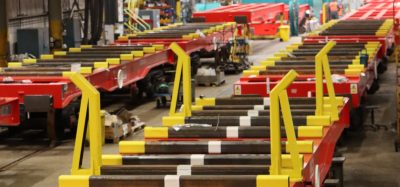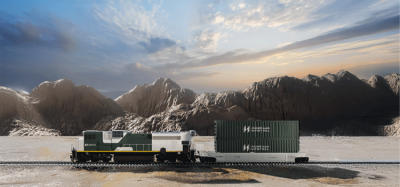Positive prospects for BLS Cargo in 2008 and beyond
Posted: 1 August 2008 | | No comments yet
With the new Lötschberg Base Tunnel as an established business model and an investment in 10 new multi-system locomotives, BLS Cargo is preparing for future growth. Dr. Dirk Stahl, CEO, looks at the prospects for the company in 2008 and beyond.
With the new Lötschberg Base Tunnel as an established business model and an investment in 10 new multi-system locomotives, BLS Cargo is preparing for future growth. Dr. Dirk Stahl, CEO, looks at the prospects for the company in 2008 and beyond.
BLS Cargo is progressing successfully. With the new Lötschberg Base Tunnel as an established business model and an investment in 10 new multi-system locomotives, the company is preparing for future growth.
With its central position in Europe, Switzerland constitutes an important hub in European rail transport. Italy’s ports, the commercially important Lombardy region, and the industries of Germany, Belgium and the Netherlands, and even beyond to Scandinavia and Great Britain, require efficient and reliable transport links. 110 million tonnes of freight cross the Alpine chain every year, and the trend is rising. One third of this tonnage passes through Switzerland. The construction of the Lötschberg and Gotthard Base Tunnels as part of the New Rail Link through the Alps (NRLA) will create the conditions in Switzerland to allow as much traffic as possible to be transferred from road to rail.
Switzerland’s transport policy attracts the attention and recognition of its European neighbours. The NRLA concept forms part of the 1999 Transport Agreement between Switzerland and the EU. The Lötschberg-Simplon and Gotthard transit routes constitute the core of Europe’s most important freight traffic corridor, extending from Rotterdam to Milan/Genoa. It is estimated that rail traffic along this corridor will increase by 86% by 2020. By facilitating substantial and jointly agreed investments, European and Swiss transport policy aims to foster the growth of rail freight services along this corridor.
The leading position of BLS and Lötschberg Base Tunnel
On 15 June 2007, the Lötschberg Base Tunnel (LBT) was officially opened. After only eight years in construction, one of the European transport policy’s biggest infrastructure projects entered operation. At the opening ceremony, EU representatives, foreign transport ministers and railway industry chiefs stressed Switzerland’s pioneering role in the planning, financing and completion of the Lötschberg base tunnel.
Since being opened, BLS Cargo has provided the majority of transit freight services through the LBT. The passage of the first BLS Cargo train was preceded by intensive planning work – existing operating procedures needed to be modified in order to ensure that high quality and punctuality was maintained for customers for services through the Lötschberg Base Tunnel. As a consequence of the new operating procedures, the framework conditions for the planning and scheduling of resources also changed.
During operational preparations, BLS AG made deliberate use of the advantages of an integrated railway. It provided the infrastructural framework, while BLS Cargo supplied most of the test trains for the efficiency-boosting phase and operational preparation. The efficiencies within the Group facilitated coordination between operational segments and enabled the Lötschberg Base Tunnel to enter service smoothly and according to timetable. Problems encountered in the implementation of other large-scale rail infrastructure projects, show that the management of such projects is extremely challenging and usually involves delayed commissioning. As a private railway, BLS accepted the challenge and, in fulfilment of Swiss transport policy, brought the Lötschberg Base Tunnel into operation on time.
Twin track upgrade needed
Since the timetable changeover on 9 December 2007, freight and passenger trains have been sharing the new capacity in the Lötschberg Base Tunnel. Traffic is flowing smoothly at present and quality and reliability requirements are being met. On peak days, 108 trains out of a maximum of 110 have already passed through the tunnel. This demonstrates that available timetable capacities are already being utilised and the propensity for bottlenecks in the tunnel will increase.
BLS Cargo will continue to optimise its use of this hugely significant building project in order to use the new capacities to advance the shift of transportation from road to rail. The present level of tunnel use, however, shows that if further substantial progress in terms of this shift is to be achieved, it will be essential for the capacity-limiting single track section of the LBT to be upgraded to twin track. BLS Cargo will strongly lobby political bodies and representative bodies for this outcome.
Success factors for strong growth
Since its founding in 2001, BLS Cargo AG has pursued a growth strategy with an annual average growth of 39% – a rate that is extraordinarily high in the industry. The high growth rates are accompanied by extremely good financial results.
For the seventh time in succession, BLS Cargo presented a growth in its rendered transportation and financial results for the past financial year. The company increased its total rendered transportation by 3% to 3,341.8 million ntkm. In its transit business, which constitutes approximately 96% of its activities, BLS Cargo was even able to increase its rendered transportation by 4.5%. The market share of BLS Cargo in Alpine transit through Switzerland currently lies at approximately 40%.
The annual results of BLS Cargo show that its business model is successful:
Clear strategy
Increasing competition demands that railways formulate clear strategies and establish clear positioning in relation to their competitors. Over the past year, BLS Cargo has grappled intensively with the positioning of the company: how does BLS Cargo differentiate itself from the other providers on the market, and where do customers see BLS Cargo as being unique?
“BLS Cargo. The Alpinists” is the result of this thought process. For six years as BLS Cargo, and previously within BLS Lötschbergbahn AG, the company undertook everything possible to ensure that the Alps did not impede the transport of customers’ freight. The challenge of Alpine transit is our longstanding core competence, and we have now made that part of our public message. As a small company, BLS Cargo lays great store on its strengths and experience in Alpine transit, on customer focus and on its specific partnerships.
Clear management and the use of synergies
BLS Cargo AG is part of the BLS Group. Depending on the operational area, the subsidiary is afforded greater or lesser latitude in its actions. For lesser, where genuine synergies within the BLS Group can be used, and for greater, where cargo-specific specialist knowledge is decisive. This is the case for example in areas such as corporate identity, the company’s schedule of services and also in the planning of cross-border production. All this is contractually defined between BLS AG and BLS Cargo AG.
BLS/BLS Cargo fully exploits the synergies provided by the integrated management of the BLS Group. Examples of this are the shared use of the locomotive drivers and locomotives, as well as the common use of workshops and overhead services.
Consolidated partnerships
BLS Cargo quickly established that the market liberalisation in rail freight services was not something that applied only to Switzerland, but had to be placed in an international context. This required the strategy of BLS Cargo to be focused on the international market. And this strategy was also implemented successfully when foreign companies were granted access to the share capital of BLS Cargo.
The objective was to develop existing strategic partnerships and create certainty for the future development of BLS Cargo. With the addition of Railion Deutschland AG and the Italian Ambrogio Group as shareholders, BLS Cargo realised synergies, opened new transport markets and acquired additional international logistical expertise.
Today, BLS Cargo regards these alliances as being markedly successful and focused on the long term. BLS Cargo AG profits from its partnerships and in return, offers its partners outstanding services in Alpine transit through Switzerland and a high degree of strategic and operational reliability. This is valued highly by the partners. BLS Cargo intends to maintain this strategic positioning and intensify and broaden its partnerships.
Cross-border production models
Since 2003, BLS Cargo and Railion Deutschland have produced their partnered transportation as continuous services across national borders. This sees locomotive drivers as well as locomotives being deployed across frontiers. Railion Br185 locomotives travel from Germany through to Domodossola (I) or Chiasso (CH) and Luino (I), while BLS Cargo Re 485 locomotives travel as far as Mannheim (D) and Offenburg (D). The locomotive drivers also remain onboard their locomotives when operating beyond national borders.
The cross-border cooperation with Railion Deutschland has proven to be extremely successful in the past. This is manifested in improved efficiency in the use of tractive units and clear quality improvements. BLS Cargo is therefore adding 10 further multi-system locomotives to its fleet. The new locomotives will serve to implement the positive growth planning over the coming years, but also facilitate cross-border services to include new services across Switzerland’s southern and eastern border.
After an intensive evaluation phase, BLS awarded the contract for the construction of the locomotives to Bombardier Transportation. BLS Cargo opted for TRAXX F140 MS type locomotives. These are a further development of the Re 484 and belong to Bombardier’s TRAXX platform, in common with the existing 20 Re 485 locomotives operated by BLS Cargo. The technical equipment on the locomotives permits them to be used in Germany, in Austria, in Switzerland and in Italy. For this, the locomotives are equipped with the ETCS and SCMT rail traffic management systems. The contract for work and services was signed by both parties on 25 September 2007. The delivery of the new locomotives has been scheduled to commence from December 2008.
Outlook
The prospects for 2008 look positive for BLS Cargo, since the economic situation shows further upward trends and new growth opportunities are emerging with the full utilisation of the Lötschberg Base Tunnel. BLS Cargo had already largely implemented new transport projects at the time of the timetable changeover in December 2007 and can therefore predict an impetus for strong growth in 2008.







